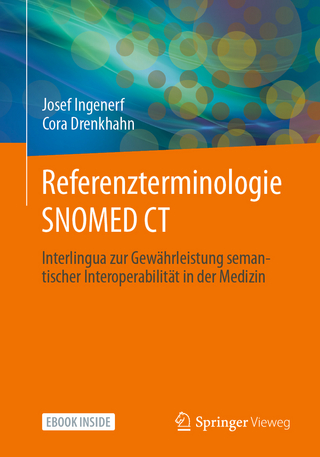
Knowledge Sharing in the Integrated Enterprise
Springer-Verlag New York Inc.
978-1-4419-3893-0 (ISBN)
- How to interchange models between enterprise modeling tools?
- How to maintain the interdependencies between models - whether they describe the enterprise on the same level (but from different points of view), or from the same point of view (but on different levels of abstraction and granularity)?
- How to maintain a coherent and evolving set of enterprise models in support onf continuous change processes?
- How to use and reuse enterprise models as a knowledge resource?
The answers to these questions are of great importance to anyone who is implementing ISO9001:2000 requirements, whether through using enterprise architecture practice or not - although it can be argued that a well executed architecture practice should satisfy ISO9001 without additional effort.
This volume attacks the problem on three fronts:
1. Authors working in international standardisation and tool development as well as in enterprise modeling research present the latest developments in semantic integration;
2. Authors who are practitioners of, or conducting active research in, enterprise architecting methodologies give an account on the latest developments and strategic directions in architecture frameworks and methodologies;
3. Authors who use or develop information integration infrastructures present best practice and future trends of this aspect of enterprise integration.
Chapters of this book include contributions to the International Conference on Enterprise Integration and Modelling Technology (ICEIMT'04), and those presented at the Design of Information Infrastructure Systems for Manufacturing (DIISM'04) Workshop. While DIISM is traditionally oriented at supporting manufacturing practice, the results have a far greater domain of applicability.
ICEIMT 04.- A’ standards’ Foundation for Interoperability.- Standards in Enterprise Inter- and Intra-Organisational Integration.- Integrating Enterprise Model Views through Alignment of Metamodels.- Semantic Distance and Enterprise Integration.- The Nature of Knowledge and its Sharing through Models.- ATHENA Integrated Project and the Mapping to International Standard ISO 15704.- Architectural Principles for Enterprise Frameworks: Guidance for Interoperability.- UEML: a Further Step.- Connecting EAI-Domains Via SOA— Central vs. Distributed Approaches to Establish Flexible Architectures.- A Meta-methodology for Collaborative Network Organisations: A Case Study and Reflections.- An Ontological Approach to Characterising Enterprise Architecture Frameworks.- Coherent Models of Processes and Human Systems.- If Business Models Could Speak! Efficient: a Framework for Appraisal, Design and Simulation of Electronic Business Transactions.- Building a Better Team.- A Reference Model for Human Supply Chain Integration: an Interdisciplinary Approach.- A Proposition for Risk Analysis in Manufacturing and Enterprise Modeling.- An Ontology for Static Knowledge Provenance.- Object Model for Planning and Scheduling Integration in Discrete Manufacturing Enterprises.- B2B Applications, BPEL4WS, Web Services and .NET in the Context of MDA.- A Research Framework for Operationalizing Measures of Enterprise Integration.- A Vision of Enterprise Integration Considerations.- Enterprise Integration Engineering as an Enabler for Business Process Management.- Deriving Enterprise Engineering and Integration Frameworks from Supply Chain Management Practices.- How to Model Business Processes with GPN.- Enterprise Integration and Networking: Issues, Trends and Vision.- Enterprise IntegrationApproaches in Healthcare: A Decade of Trial and Error.- An Enterprise Modelling Approach to Team Systems Engineering.- Improving Supply Chain Performance through Business Process Reengineering.- Toward the Knowledge-based Enterprise.- Strategic Process Integration.- DIISM 04.- Manufacturing and Engineering in the Information Society: Responding to Global Challenges.- Considering Designer’s Intention for the Development of Feature Library of a Process Planning System.- Manipulation Planning for Knotting Linear Objects with One Hand.- Cost Prediction System Using Activity-Based Model for Machine Tool Operation.- Information Modeling for Product Lifecycle Management.- Generic Core Life Cycle and Conceptual Architecture for the Development of Collaborative Systems.- Integrated Process Management System and RFID Directory Services.- Seven Tools of Operation Standardization for Mass Production of a New Product.- Workbench: A Planning Tool for Faster Factory Optimization.
| Erscheint lt. Verlag | 8.12.2010 |
|---|---|
| Reihe/Serie | IFIP International Federation for Information Processing ; 183 |
| Zusatzinfo | XIV, 458 p. |
| Verlagsort | New York, NY |
| Sprache | englisch |
| Maße | 155 x 235 mm |
| Themenwelt | Informatik ► Theorie / Studium ► Algorithmen |
| Mathematik / Informatik ► Mathematik ► Finanz- / Wirtschaftsmathematik | |
| Technik ► Maschinenbau | |
| Wirtschaft ► Betriebswirtschaft / Management ► Logistik / Produktion | |
| Wirtschaft ► Betriebswirtschaft / Management ► Unternehmensführung / Management | |
| ISBN-10 | 1-4419-3893-1 / 1441938931 |
| ISBN-13 | 978-1-4419-3893-0 / 9781441938930 |
| Zustand | Neuware |
| Haben Sie eine Frage zum Produkt? |
aus dem Bereich


